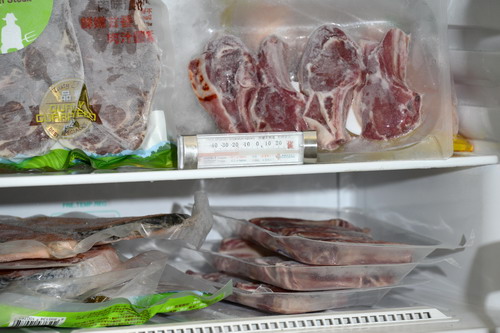
Food Safety Focus (109th Issue, August 2015) – Incident in Focus
Frozen Foods - Are They Safe?
Reported by Dr. Anna TANG and Dr. John LUM, Scientific Officer,
Risk Communication Section,
Centre for Food Safety
Recently, there have been concerns as to whether frozen foods kept for long durations are safe for consumption. This article looks into various issues of freezing and food safety.
Freezing as a Means of Food Preservation
Freezing is a common way to preserve raw meat or cooked food for later consumption. The freezing temperature (-18°C or below) inhibits the growth of microbes (e.g. bacteria, yeasts and moulds, including pathogens) which may otherwise cause the food to spoil or be unsafe for consumption. As such, food stored at a stably maintained freezing temperature could be kept safe for a prolonged period of time. The US Department of Agriculture opines that food safety of properly stored frozen food could last almost indefinitely! Although freezing keeps the food safe for consumption, the organoleptic quality of the food may deteriorate upon long-term freezing. There may be changes in meat texture, fat can crumble and meat colour may also change because freezing slows down but does not totally stop the actions of certain enzymes naturally present in animals and vegetables which would cause food components to degrade or oxidise.
Freezer Storage Duration
Although freezing can keep food safe for a very long period, the food industry will not label the storage time of frozen food as indefinite. The quality of food also needs to be considered when determining the storage duration. The storage duration for frozen food (usually in terms of months or years) is usually set out as a quality indicator. The duration may be reduced if the freezer temperature cannot reach -18°C or fluctuates to above -18°C.

Ensure that frozen food is kept at -18°C or below by checking the temperature with a thermometer placed inside the freezer.
Proper Thawing to Ensure Food Safety
Frozen food should be thawed properly to ensure food safety. Although the growth of microorganisms is inhibited when frozen, they may not be killed and may become active again when food is thawed. Therefore, food should not be thawed at room temperature because the process will take a long time and microorganisms, including pathogens, can multiply before the food is entirely defrosted. This may render frozen cooked food or frozen ready-to-eat food unsafe and increase the risk of cross-contamination by frozen raw food. Frozen food should be thawed in a refrigerator (0°C - 4°C), under cold running water, or in a microwave oven. Frozen food thawed under cold running water or in a microwave oven has to be cooked immediately after thawing. Refreezing of thawed food is generally not recommended, unless the warmest temperature of the thawed food is still kept below 4°C. Once thawed, the food becomes perishable again and should be prepared as intended and consumed as soon as possible.
Best Practices in the Cold Chain
For traders, good temperature control is essential along the cold chain (include receiving, processing, storage, transport, distribution and retailing) for maintaining the safety and quality of frozen food. Temperature should be monitored along the cold chain in order to ensure that a freezing temperature is maintained, within permitted tolerances which do not affect safety and quality. The Codex Code of Practice for the Processing and Handling of Quick Frozen Foods (CAC/RCP 8-1976) provides guidance on the processing and handling of frozen food to help ensure product safety. The trade is also reminded to observe good hygienic and good manufacturing practices and to develop a Hazard Analysis and Critical Control Point (HACCP) programme for each operation in the cold chain.
The import of meat and poultry (including frozen products) requires an import licence under the Import and Export Ordinance (Cap. 60). Trade members are reminded to ensure that there are relevant health certificates for all meat and poultry imported under the Imported Game, Meat and Poultry Regulations of the Public Health and Municipal Services Ordinance (Cap. 132) and that the record keeping requirement is met under the Food Safety Ordinance (Cap. 612).
Key Points to Note:
- Frozen food can be kept safe for extended periods if handled properly and stored constantly at -18°C or below.
- The quality of frozen food may diminish with increasing storage time as deterioration continues to take place at a slow rate.
- Frozen food should not be thawed at room temperature because the process will take a long time and pathogens can multiply before the food is entirely defrosted.
Advice to the Trade
- Ensure good temperature control along the cold chain to maintain the safety and quality of frozen food.
- Display frozen food for sale inside freezer cabinets with proper temperature control at -18°C or below.
- Follow first-in-first-out rule for sale and for food preparation.
Advice to Consumers
- Purchase frozen food offered for sale in freezer cabinets.
- Use thermometers to monitor the temperature of the home freezer compartment to ensure that frozen food is kept at -18°C or below.
- Thaw frozen food in a refrigerator (0° - 4°C). For faster thawing, food can be thawed under cold running water or in a microwave oven, but the food has to be cooked immediately after thawing.

